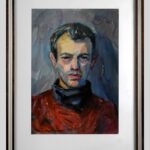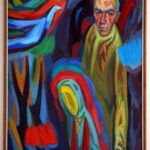
Tuleikis Leonardas
LEONARDAS TULEIKIS 1939 January 25 – 2014 April 20
1958 – started living in Vilnius.
1963 – graduated from the Vilnius Institute of Art (now Vilnius Academy of Art),
started participating in exhibitions.
1966 – admitted to the Lithuanian Artists’ Union.
1975-1976 – interned in Italy.
Lives and creates in Vilnius, in the summers – in Plateliai.
L. Tuleikis – a member of the individualist artists’ group operating in Lithuania.
His works are exhibited in Lithuania, shown in art exhibitions organized in England, Estonia, Georgia, Italy, Japan, USA, United Arab Emirates, Latvia, Russia, Finland, Germany.
Personal exhibitions:
1972 – in Bydgoszcz (Poland);
1975, 1985, 1989, 1999 – Vilnius;
1975 – Kaunas;
1989 – Panevėžys.
Leonardas Tuleikis – one of the most famous Lithuanian artists of the second half of the 20th century, who participated in almost all Lithuanian art exhibitions both in our country and abroad. In 1975-1976, he trained in Italy. He was among the avant-garde artists of that time, who legitimized the principle of deformation in Lithuanian painting, and modernly perceived the use of folk art traditions – not by repeating motifs, but by seeking inspiration in the field of plastic form interpretation. L. Tuleikis actively defended the positions of true art both as an artist and as the head of the painters’ section of the Lithuanian Artists’ Union and a member of the board. Not a single painting triennial of the Baltic States was complete without his works.
In 1989-1999, like most of his fellow artists, he locked himself in his studio, because he painfully experienced the loss of aesthetic and ethical ideals in the new postmodern environment. He reappeared in the public art space at the “Exhibition of Unknown Lithuanian Paintings of the Last Decade of the 20th Century”, having previously occasionally appeared in exhibitions organized by the Individualist Group.
Leonardo Tuleikis’ painting was always overly serious, captivating with psychological depth, and his plastic language was meaningful, radiating spiritual tension. The artist’s worldview was solid in the Samogitian style, encompassing the essential problems of human existence, not deviating from superficial details, often dramatic, touched by experiences of suffering. His paintings are characterized by a unified composition, internal expression and constant tension, created by combinations of deep, heavy color tones and a constructive image structure. Every area is always amazingly masterfully painted, every shade is coordinated, smooth and rough textures, the rhythm of planes and strokes, and most importantly – such a lively glow of colors that we are used to seeing in stained glass. Here you will no longer find the impression of easy play, even when he uses bright or lighter colors.
The motifs chosen by the artist are very simple: a few mighty trees, still lifes of rural life, human figures, which are presented as an inseparable part of nature and other environments. And the images created make you think about the complex issues of human existence. Although the artist has lived in the city for a long time, his strongly generalized decorative paintings are filled with the spirit of the Lithuanian village, intoxicating greenery and the fullness of blooming nature, surprising with red sunsets that came from childhood memories.
The works of the last decade are distinguished by brighter colors, glowing blue shadows reminiscent of Impressionism, increased decorativeness, and a longing and hopeful mood. (Doc. Nijolė Tumėnienė)



